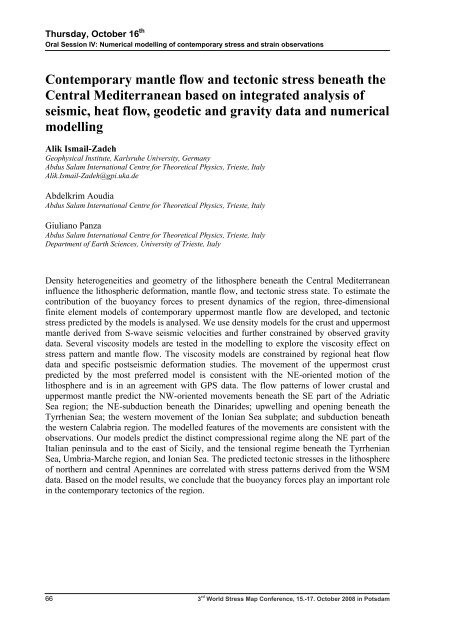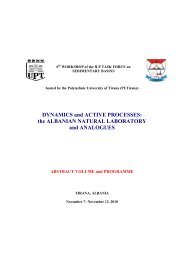World Stress Map Conference - International Lithosphere Program ...
World Stress Map Conference - International Lithosphere Program ...
World Stress Map Conference - International Lithosphere Program ...
You also want an ePaper? Increase the reach of your titles
YUMPU automatically turns print PDFs into web optimized ePapers that Google loves.
Thursday, October 16 th<br />
Oral Session IV: Numerical modelling of contemporary stress and strain observations<br />
Contemporary mantle flow and tectonic stress beneath the<br />
Central Mediterranean based on integrated analysis of<br />
seismic, heat flow, geodetic and gravity data and numerical<br />
modelling<br />
Alik Ismail-Zadeh<br />
Geophysical Institute, Karlsruhe University, Germany<br />
Abdus Salam <strong>International</strong> Centre for Theoretical Physics, Trieste, Italy<br />
Alik.Ismail-Zadeh@gpi.uka.de<br />
Abdelkrim Aoudia<br />
Abdus Salam <strong>International</strong> Centre for Theoretical Physics, Trieste, Italy<br />
Giuliano Panza<br />
Abdus Salam <strong>International</strong> Centre for Theoretical Physics, Trieste, Italy<br />
Department of Earth Sciences, University of Trieste, Italy<br />
Density heterogeneities and geometry of the lithosphere beneath the Central Mediterranean<br />
influence the lithospheric deformation, mantle flow, and tectonic stress state. To estimate the<br />
contribution of the buoyancy forces to present dynamics of the region, three-dimensional<br />
finite element models of contemporary uppermost mantle flow are developed, and tectonic<br />
stress predicted by the models is analysed. We use density models for the crust and uppermost<br />
mantle derived from S-wave seismic velocities and further constrained by observed gravity<br />
data. Several viscosity models are tested in the modelling to explore the viscosity effect on<br />
stress pattern and mantle flow. The viscosity models are constrained by regional heat flow<br />
data and specific postseismic deformation studies. The movement of the uppermost crust<br />
predicted by the most preferred model is consistent with the NE-oriented motion of the<br />
lithosphere and is in an agreement with GPS data. The flow patterns of lower crustal and<br />
uppermost mantle predict the NW-oriented movements beneath the SE part of the Adriatic<br />
Sea region; the NE-subduction beneath the Dinarides; upwelling and opening beneath the<br />
Tyrrhenian Sea; the western movement of the Ionian Sea subplate; and subduction beneath<br />
the western Calabria region. The modelled features of the movements are consistent with the<br />
observations. Our models predict the distinct compressional regime along the NE part of the<br />
Italian peninsula and to the east of Sicily, and the tensional regime beneath the Tyrrhenian<br />
Sea, Umbria-Marche region, and Ionian Sea. The predicted tectonic stresses in the lithosphere<br />
of northern and central Apennines are correlated with stress patterns derived from the WSM<br />
data. Based on the model results, we conclude that the buoyancy forces play an important role<br />
in the contemporary tectonics of the region.<br />
66 3 rd <strong>World</strong> <strong>Stress</strong> <strong>Map</strong> <strong>Conference</strong>, 15.-17. October 2008 in Potsdam




